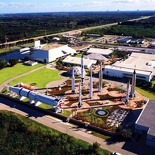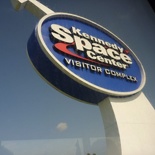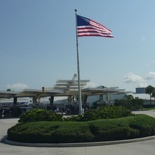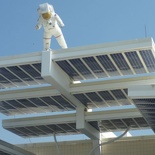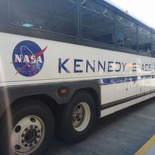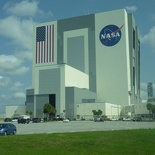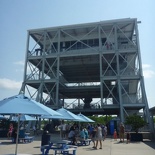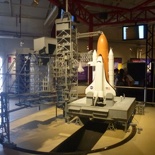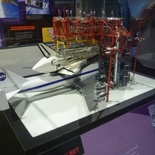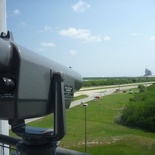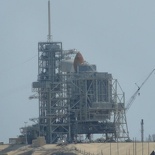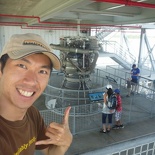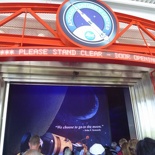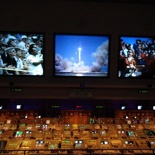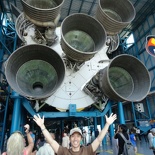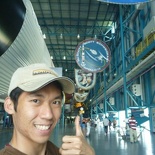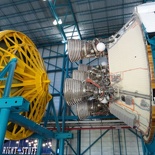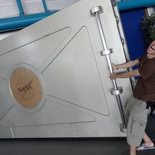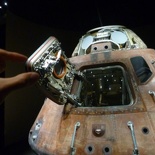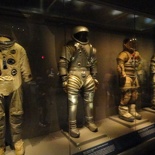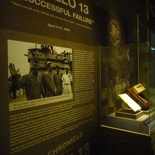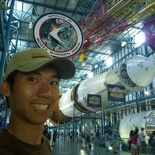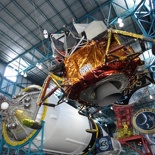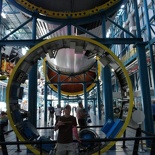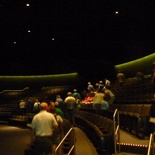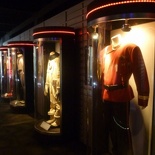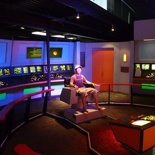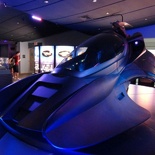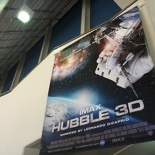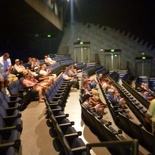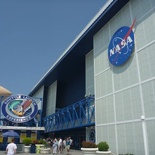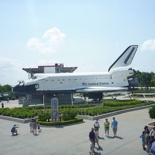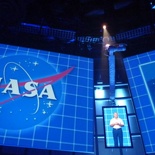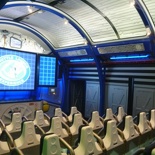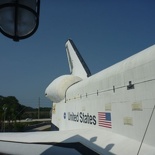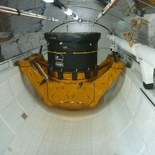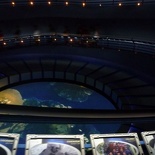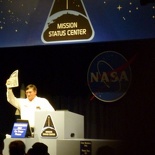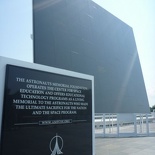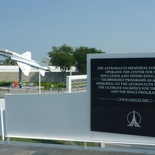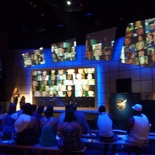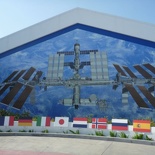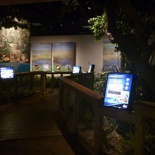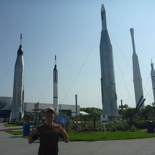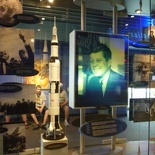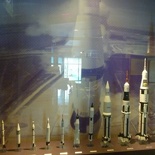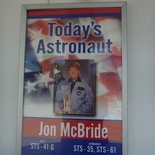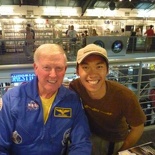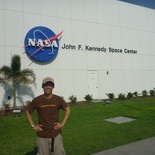The NASA Kennedy space center (KSC) is a space launch facility for every United States human space flight since 1968. It is located on the Merritt Island, Cape Canaveral, Florida with both public and off limit space facilities. Given the need for remote launch sites literally in the middle of nowhere with minimal rainfall and always-clear skies (what this part of Florida is known for), the space center is located in a rather isolated location and for most people, getting there means driving there or taking paid public transport to the space center itself.
The Merritt Island is located mainly on a marsh like, shrub area, with mostly swamps with mostly short brush-like vegetation all around. There are not many tall forests around here and is a protected nature reserve area for native and migratory spices, particularly birds. Our journey there begins from an early bus departure at 7.30am along International Drive in Orlando, Florida. This bus we boarded is operated by an agency specializing in transport to the Space center itself. For $90, you get a return trip to the space station including entrance fee. The bus started picking up guests along route along the way to the center. Our bus driver was this cool guy called Mike from Gray tours, who kept doing impersonations of Houston and had been driving the route for years. Rather entertaining guy nonetheless.
Kennedy Space Center was created and has evolved to meet the changing needs of America’s manned space program from conception till today, initially in competition with the Soviet Union as kicked off by John F Kennedy. The visitor complex portion of the Kennedy Space Center is what most visitors will come to upon arrival at there. This public area is set with an exhibition center with theaters and “spacey” rides for all ages alike. The park is operated by 700 employees by Delaware North since 1995 and attracts about 1.5 million visitors annually.
The highlight of the space center will have to be the center tours. The bus tours of KSC originate from here. You board air-conditioned tour buses which will take you to the 2 main sites within the space center itself, passing by various iconic structures, installations and plants as part of the guided bus tour. After boarding these buses, it’s only a matter of no time where we are back on the public roads heading out of the visitor center area and out into the outer restricted working areas of the space center.
Here you will get to see the iconic Vehicle Assembly Building (VAB), which is a hulk of a structure and is the fourth-largest enclosed structure in the world by volume. It’s blessed with a cavernous interior and home to few massive heavy cranes. The assembly building is where the solid rocket boosters become attached to the main fuel tank together with the shuttle, which is then hoisted from a horizontal to vertical position to be mounted on the main tank onto the crawlers in preparation for movement to the various launch sites around the facility.
The first stop was the LC 39 Observation Gantry. It’s essentially 60-foot-tall Launch Complex located near the old crawler storage facility. The crawlers are large hunkering track based platforms which the whole assembled shuttle, rocket boosters and fuel tank are placed on, to be moved the respective launch sites. They move extremely slow and usually take a whole night to make the short 5 kilometer travel from the VAB to the shuttle launch site. Those long white gravel and sand strips you see running along side the main roads are the specially made paths for the crawlers themselves leading up to the respective launch sites.
At the gantry, you will be brought through a pre-show screening in a theater and a mini exhibition area featuring cutaway sections of the launch complex, alternative shuttle launch configuration as well as try-it interactive booths before exiting out into the open for the attraction’s observation tower. The gantry is 3 floors high and is served by both stairs and lift landings on every floor. On the first floor sits the engine of the fallen shuttle Challenger. From the top you can catch distant views of Launch Complex 39–Pad A and 39–Pad B.
There are a number of launch pads in the area, some decommissioned and preserved for display and educational purposes. Since December 1968, all launch operations have been conducted from Pads A and B at Launch Complex 39. Both pads are situated near the ocean, about roughly 5km east of the VAB. There are many more pads around the Merritt Island area with a large number of them still active for larger rockets.
During my visit, Space shuttle Atlantis (STS-135) was up on the launch Pad 39 preparing for launch after the 4 fourth of July. Seeing the space shuttle on the launch pad is something we will all never see again ever with the decommissioning of all NASA’s shuttles for future launches. Moving on with your bus tour will bring you to the Apollo/Saturn V Center, which is north of the VAB and the area where you will spend a substantial amount of time in your trip.
You start off by entering a Launch Control Center where you will be put through simulations of the Saturn V rocket launch procedures itself, the one which placed the first man onto the moon. It’s a complete mock-up with an re-enactment of the launch control sequence and checks, with special vibration and lighting effects included! You exit the theaters right into the air conditioned Apollo/Saturn V Center hangar exhibit area, where you will be greeted with the massive rear of a Saturn rocket itself. The rocket itself was dissected into it’s respective blast stages for indoor center stage display and spans the whole length of the Saturn exhibition center, which looks like a large storage hangar with a sub-attached building. The Saturn center is also home to the United States Astronaut Hall of Fame. The whole facility itself is roughly 10 kilometers from Titusville.
It’s here where you can grasp the sheer size of the Saturn 5 rocket in the center, spanning over 110.6m in length and over 3039 tons in weight. Currently decommissioned, the design had it’s maiden flight (SA-501) in 1967 and was built by Boeing, North American Aviation, Douglas Aircraft, and IBM. Until today, it remains the tallest, heaviest and most powerful rocket brought to operational status ever known to mankind. It still holds the record for the heaviest launch vehicle payload. It placed 24 men on the moon from 1968 through 1972.
There are several other exhibits in the hangar too, such as lunar modules, the NASA vault and many other info booths of various space hardware of interest as well as touching on the history and future of human and robotic spaceflight. The facility is also home to a moon rock cafe and the attraction gift shop, stocking lots of NASA themed merchandise as well as limited edition commemorative medals and fixtures of all the shuttle space flights. The Vault here is an exhibition containing various archives of the space technological evolution time line of NASA, with plenty of old artifacts on display including the Apollo 14 capsule as well as a collection of old space suits and bits of pieces of spacecraft from the various past Apollo mission themselves.
The Saturn V pad spots a massive movie theater, the Lunar theater. The theater teaches about the challenges and incredible accomplishments the Apollo moon program had brought to to mankind as a whole, with a tribute to the Apollo astronauts and the machines that brought them there and home safely. The movie exits into the souvenir store where you can hop right out into the bus bays for the return trip back to the visitor center or head back into the Saturn 5 complex for an encore. The merchandise at the NASA store is really like a nerd haven, with loads of cool space related gear including science kits. Well, it got out the impulsive nerd in me, there were quite a number of nerdy NASA themed T-shirts which caught my eye too, resulting in a number of apparel purchases as usual.
The bus journey back saw us through the crawler section of the facility, just before our destination. It was not long before we are back at the visitor center. With the major external space facility section of the KSC tours done, we pretty much had the rest of the afternoon to explore all the remaining attractions in the “theme park” section of the space center. The center is home to a number of “theme park” related attractions, comprising of rides, theaters, exhibits and exhibitions. There was a Star trek exhibition going on at the atrium of the IMAX theater complex, featuring many authentic props, costumes, weapons and settings all used in the series itself. A total treat for all space fan, particularly the trekkers.
We were in time for our afternoon IMAX show (2.30pm), the entry tickets grants you to unlimited views of the cinema during your visit, there were 2 shows on rotation between 2 theaters there (Hubble 3D and Space Station 3D), so you can catch any of them at your discretion and schedule. I went for the Hubble telescope IMAX 3D movie, it’s the exact same IMAX video they were screening at the Washington Air and Space museum, as well as the Singapore Omni theather as of now. The 3D film was narrated by Leonardo Dicaprio. As with all IMAX theathers, the screen is a huge five-story behemoth. The use of 3D digital film-less formats is fast becoming a norm in all US based theather attractions, it seems that 3D is an expected feature in all theme parks now, including Disneyland, Universal and even here. The effects are cool too, allowing you “float’ alongside NASA astronauts through stereoscopic cameras shots employed on the space walks, immersing viewers with the astronauts on their journey in full 3D depth. It makes you feel like you are there with them, adding to the thrill of space exploration.
Next up, it’s back up the shuttle plaza for another ride of a different kind, the Shuttle launch experience. The attraction building sits right in front of the shuttle plaza, it’s an open air plaza where Space Shuttle, Explorer (a replica shuttle) resides. The Shuttle launch experience was touted as the most accurate shuttle launch simulator you can find on the planet, as vouched by fellow astronauts themselves as part of the pre-ride video screenings and holding areas of the ride. Thereafter you will be split into various group rows to broad you simulator, almost set like “Star Tours” in Disneyland. The ride begins with you tilting nearly up to vertical for the launch as you go for a launch in a passenger module located in the shuttle’s payload area. Personally I found the ride to be just a massive vibrator or sort. With very hilarious flabbing results on rather well, physically well-endowed people on the ride. The ride ends with the Shuttle’s payload top hatch opening to reveal the vast milky way after achieving geostationary orbit.
The shuttle experience ride exits out back to the shuttle plaza through a rather nice space-station like indoor walkway. The exit area is a circular descending walkway with it’s handrails decked out with the photos of the missions and crew member photos of every single space shuttle mission, all laid out along the handrail. The handrail ends at the bottom of the passageway with 2 empty slots filled with the generic NASA logos, which is to be filled by the upcoming and last STS-135 mission. Back on the Explorer Space Shuttle in the shuttle plaza, it is a replica space shuttle made with many genuine shuttle parts, including the internal crane, cargo bay and exterior heat tiles. This shuttle was primarily built as a mock up for educational purposes and never saw entry into space. A nearby large dome shaped structure by the Explorer sits the Launch status center. It’s a presentation of the space race the US had with the Soviets and how it fueled the rapid development for space exploration in the past.
Just off the launch control center is The Astronaut Memorial. The outdoor memorial honors every single astronaut and test pilot who died in the line of duty for the space program. This includes the 24 fallen U.S. astronauts as those from Space Shuttle Columbia, the Space Shuttle Challenger and Apollo 1. The main memorial is actually a marble lined it’s blast deflector with all the names of the fallen craved into it. It’s a national memorial by Congress and President George Bush, dedicated in 1991. Around the gardens here are early test planes which pioneered the technological development of the space program too.
There are a number of exhibition areas showcasing many of NASA’s achievements as well as space gear around the facility grounds. The nearby lunar module from the memorial is an air-conditioned dome featuring a launch status center and discusses the space race back in the early days. The Exploration space exhibit showcases is one about the progress and current direction of the NASA space program, together with a stage showcase and various interesting machines from the space program which never quite make it to where they were intended to go, like the impressive looking lunar module and the all terrain equipment transporter.
The Nature and technology displays across the rocket garden showcases more of the natural environment and animal species residing in the immediate area, particularly Cape Canaveral and the Merritt Island itself, with both of them being home to many indigenous species and is a protected nature sanctuary and wildlife migratory bird nesting ground. Covered here too are the history, way of life and early agreements of the use of the Florida grounds land here for the space program, as well with various miscellaneous ecology and stuff relating to the natural wildlife around the immediate area and the repercussions they cause.
Having mentioned the rocket garden, the garden itself is a display of missiles, sounding rockets and orbital space launchers all decked in an open outdoor area. As most rockets are generally expendable items, all the items on display here have not been flown. The collection here, started in 2004 is ever expanding with new additions added over time, residing here is a Jupiter-C/Redstone rocket, as well as the Mercury/Redstone, Thor, Mercury/Atlas and Gemini/Titan II just to name a few. As in the case of the Saturn V (the world’s biggest and heaviest rocket), many of the decommissioned Saturn rockets found their way here with later planned missions canceled, leaving these unneeded rockets for the museums for display.
The early space exploration building containing a variety of olden day displays of the early space program as fueled by the push from John F Kennedy in his desire to put the first man on the moon. The facility is located at the end of the rocket garden just off the nature an technology building. Here, various old space gear and test equipment are displayed, including weather balloons, probes and memoirs of fearless test pilots on their experiences of hitting supersonic flight for the first time and going on untested equipment and trail runs in general. Interesting too was the rapid evolution of rocket size and technology over the years, which eventually led to the first man on the moon.
The space center is also home to the largest space shop in the world, selling well, everything spacey! The gear includes stuff for all ages and interest alike- NASA merchandise, space kits, telescopes planetary sets for kids as well as many attraction specific souvenirs, medals and commemorative patches of the various shuttle and Apollo missions. Technically, it’s a NASA space freak’s dream come true and is surprisingly popular with all the park guests here.
Astronaut Jon McBride was around too, he was the Pilot for shuttle mission STS-41G and the mission commander for STS-35, STS-61. It’s not everyday where you get to meet and chat with an astronaut, not to mention getting his autograph!
The trip to the space center is generally good for a whole day, from the morning till about 6pm (closing time) in the evening, it’s very much a whole day affair with plenty of time left for the evening. Not a problem in Florida with so much to do here Downtown and back along International Drive.
- New York City & Brooklyn (Photos: New York City & Brooklyn)
- New York Hudson River Cruise, Wall street and Rockefeller Center
- American Museum of Natural History (New York) (Photos: AMNH)
- Washington D.C. (Photos: Washington D.C.)
- Newseum, Washington DC (Photos: The Newseum)
- National Gallery of Art, Washington (Photos: National Gallery of Art)
- Arlington National Cemetery, Washington DC (Photos: Arlington National Cemetery)
- Smithsonian Natural History Museum (Photos: NMNH)
- Smithsonian Air and Space Museum (Photos: Air & Space Museum)
- Orlando, Florida & Magic Kingdom at Walt Disney World Resort (Photos: Disney Magic Kingdom)
- Orlando Disneyland Hollywood (MGM) Studios (Photos: Disneyland Hollywood Studios)
- NASA- Kennedy Space Center, Merritt Island, Cape Canaveral (Photos: Kennedy Space Center)
- Islands of Adventure, Orlando Florida (Photos: Islands of Adventure)
- Universal Studios Orlando, Florida (Photos: Universal Studios Orlando)
- Miami Florida, South Beach and Aventura mall (Photos: Miami Florida)
- Pittsburgh, Pennsylvania (Photos: Pittsburgh, Pennsylvania)
- Cedar Point coaster kingdom, Sandusky Ohio (Photos: Cedar Point)

